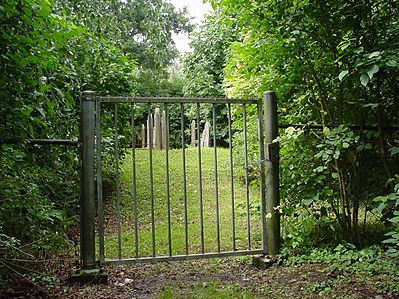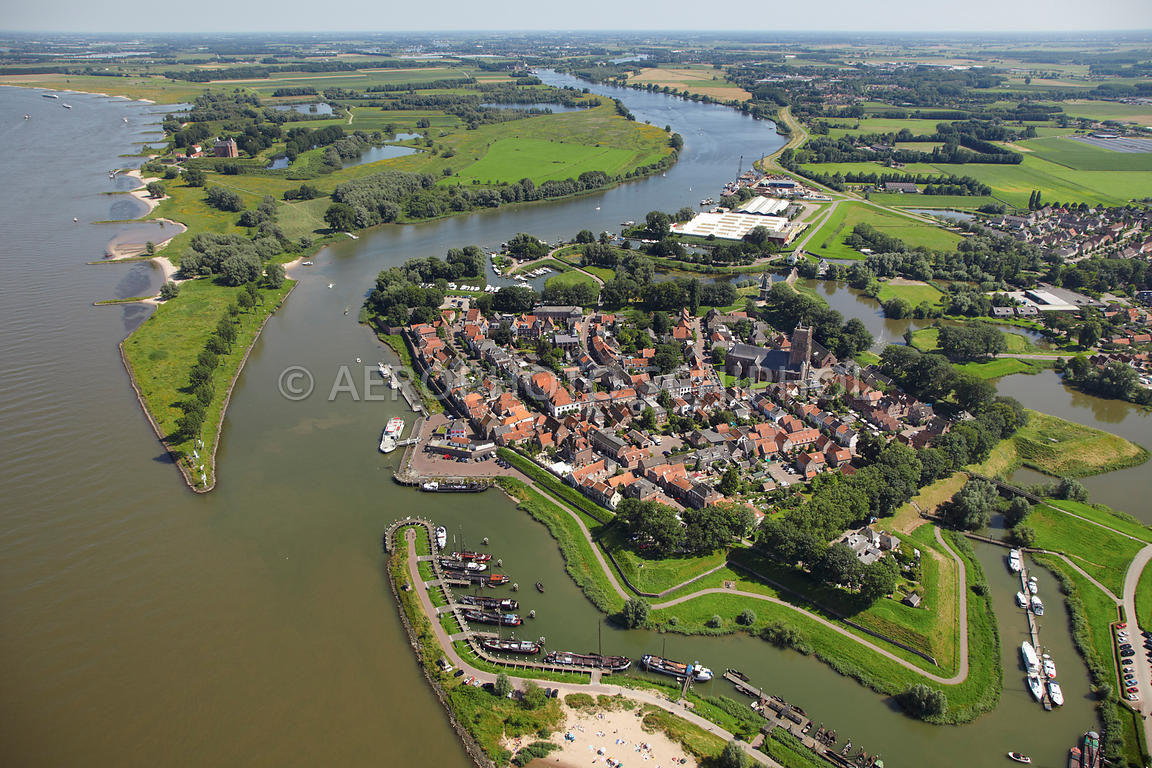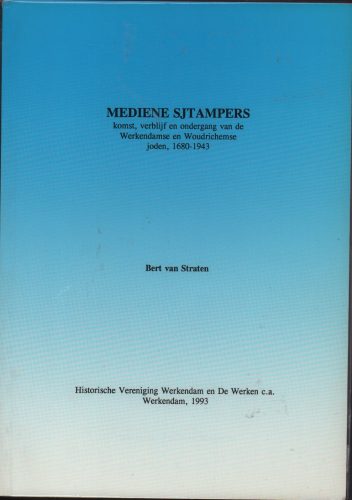The Jews in Werkendam and Woudrichem
Source: Mediene Sjtampers, komst, verblijf en ondergang van de Werkendamse en de Woudirchemse Joden, 1680-1943, by Bert van Straten
Published by the Historische Vereniging Werkendam en de Werken C.A., Werkendam (1993)
ISBN 9080151319
Introduction
Werkendam and Woudrichem (Worcum) are two municipalities near the Merwede river. Werkendam owes its existence to the dam, which was built around 1230 to close off the small river Werken. Woudrichem (also known as Worcum or Woerkum) is the only city and capital of the Land of Altena, and is located at the confluence of the Maas, Waal and Merwede rivers. Although Werkendam was not part of the Land of Altena (a former fiefdom), the Lord of Altena was its liege lord in 1381.
While Jewish communities had long existed in other European countries, little is known about the presence of Jews in the Netherlands before 1200. If they were present at all, it could only have been a few. The reason why a small number settled on our soil was probably the result of migration from the overpopulated areas of Cologne, Worms and Mainz, the banishment of Jews from England in 1290 and from France in 1306.
The first Jews in Werkendam and Woudrichem
It is not until the end of the 17th century that the first Jewish presence in Woudrichem can be ascertained, when a pawnbroker’s shop was in Jewish hands. Jews were given permission to set up shop in Werkendam towards the end of the 18th century. Woudrichem was a trading town; its three free annual fairs attracted all sorts of people, among them Jewish traders and pedlars, which accounts for their earlier presence there. Both towns were historically located in the County of Holland, where Jews were admitted earlier than in the Duchy of Brabant.
The earliest known Jewish presence in Werkendam can be dated back to 1748 when a child from Werkendam was buried at the Jewish cemetery in Zaltbommel. This could have been a child of a Jew who settled in Werkendam in 1748, evidenced by the fact that he had to pay municipal taxes at the beginning of 1749 for the previous six months. Another Jew was registered in 1753, presumably a relative of the first mentioned. An Israelite birth register from 1782 gives further evidence, that Jews lived in the area at that time.
Synagogue
There must have been a “home” synagogue early on, going by a declaration that the Jews did not lay claim to the building of the local Dutch Reformed church.
What the family is for the individual, the synagogue is for the Jewish community. It is a place of worship, of study and of community life. It contains the Holy Ark in which the Torah scrolls are kept, and which is always erected in the direction of Jerusalem. At the front is the Bima (reading desk), from which the cantor leads the prayers, and where the reading from the Torah scrolls takes place. The synagogue also has a chanukiah (eight-branched candelabrum).
After services were held for years at someone’s home in Werkendam, a “decent church room” became available. Forty years later the community rented a building in which they could hold services. Before that portable synagogue equipment was available from travelling Jewish merchants which could be set up in a rented room.
Later on a shul (synagogue) was established in Werkendam in a shed behind a house in the Hoogstraat. This house was sold in 1876, and the new owner continued to let it for 50 guilders per year. We only know that it contained furniture and ornaments and two Torah scrolls. The Chazzan (reader) was later replaced by someone who also functioned as Shochet (ritual slaughterer) and teacher. Thus there must also have been a school for the Jewish children.
The synagogue was in use until about 1900, after which it ceased to exist. After 1918 the Jews from Werkendam and Woudrichem went to the shul in the nearby city of Gorinchem, where the ritual bath (Mikveh) was also used.
Cemetery
According to Jewish tradition, Jewish cemeteries are built outside towns or villages, as a dead body is considered unclean. There are therefore no cemeteries around synagogues. But the body of the deceased is treated with great respect. In 1850 a piece of land, bought in the Vervoornse polder near Werkendam, was intended for use as cemetery. This would not however have been the first cemetery, as burials could already be held in 1799. Even that would not have been the oldest cemetery in the Land of Altena and Werkendam, for in 1798 there was already talk of a lost cemetery in Woudrichem’s Oude Banne, called the “Jew cemetery”. As far as we know now, that was the earliest known cemetery. But it had not been in use since 1798, and in the archives nothing can be found on an earlier presence of Jews in Woudrichem. This cannot be ruled out of course, as it was the gateway to the Land of Altena. When the Count of Holland established his border toll there in the 15th century, there was much commercial activity in the area, which would have attracted Jewish commercial travellers as well.
When Jews first resided in Werkendam and Woudrichem they had great difficulty in burying their dead. They had to be transferred to cities like Zaltbommel, Dordrecht, Besoyen and Gorinchem, which meant difficult, long and sad treks in all weathers across rivers and winding dikes.
In 1849 it was recorded that the Israelites in Werkendam had a special cemetery on the so-called Hofstede in the Vervoornepolder. The plot was not owned by the Jewish community, but belonged to the mayor who leased it out to them. It is not known when the first burial was held there, but burials probably took place in Werkendam from 1799. Until that year the marriage and burial register shows that Jews were buried in the aforementioned places, but from 1799 this is no longer the case. It was probably due to lack of space that there were no more burials at the Hofstede after 1850. In 1853 it was laid down by notarial deed that there was to be no delving, digging, sowing or planting, and that it should be left untouched. This was according to Jewish regulations regarding the management of Jewish cemeteries.
In order to retain the possibility of burial, the aforementioned plot in the Vervoornse polder was bought, and this cemetery exists to this day. A few Jews from Woudrichem have indeed been buried there. The cemetery is now maintained by the Werkenham municipality.
The Jewish community and life in the Mediene (Jewish communities in the provinces)
When exactly the first Jewish community in Werkendam/Woudrichem was established, is difficult to say. Maintaining a Jewish identity within a predominant Dutch Reformed society was probably a gradual process. An Israelite birth register in Werkendam from 1782 gives the first clear indication of an organised Jewish structure. There were apparently other registers, but they have been lost. Another indication of the existence of a Jewish community concerns a declaration by the “Heads of Jewish families” from 1798. During the same period the separation of church and state came into force in the Netherlands.
In the first forty years of the 19th century Werkendam and Woudrichem alternated as regional centres for the Jewish community. In Woudrichem there was never a separate area which functioned as synagogue. “Home” services were held in a cellar room, set up for this purpose in a house in the Hoogstraat. This “subsidiary church” had to contribute 25 guilders each year towards the expenses for the Chief Rabbi.
The church warden had to make sure that this was fairly divided among the members of the community. As some of them did not contribute, Woudrichem’s “subsidiary church” was in a sorry state, not helped by the bad contact between the two groups. When the “subsidiary church” in Woudrichem eventually disappeared, Werkendam became the regular centre, although here there were problems as well. Werkendam’s “subsidiary church” consisted of nine families in 1836. Its yearly budget was 120 guilders, of which 60 was reserved for the Cantor’s salary. The rent for the church room was 33 guilders per annum. Clearly the members of the community had to contribute, but this was problematic, especially for Woudrichem’s Jews. Thus few administrative activities have been reported from the turn of the century.
For Jews life in the province, the Mediene (Hebrew for “State”), was determined by their religion, the accompanying obligations, their small number and the local circumstances. Jews in the Mediene were dependent on the non-Jewish community. Up to the French era in the Netherlands they had been regarded as foreigners, belonging to the “Jewish nation”. They had governed themselves under supervision of the local authorities.
In 1796 this self-government was terminated, and in that same year Jews received equal rights and were admitted as citizens. A process of change and adaptation was set in motion, which meant for example that the use of Yiddish in services and at schools was discouraged. Local Jews had to become “Werkendammers and Woerkummers” who expressed themselves in the local dialect. Yet there was a certain degree of tolerance in Werkendam and Woudrichem, compared to other places. Despite this relations were not always easy.
The Jews living in this area were nearly all Ashkenazi (from central and Eastern Europe). According to the municipal registers there were about 31 Jews in 1800 and about 45 in 1860. Jews from the provinces were mockingly called “Mediene sjtampers” by their fellow Jews in Amsterdam. Woudrichem was added to the Jewish community in Gorinchem in 1918, and Werkendam in 1921.
Means of existence
In 1753 a Jew received permission to carry out his trade as slaughterer and butcher of oxen, cows, calves and sheep, and in 1771 a Jew was allowed to sell butter. Somewhat later more Jewish slaughterers and butchers arrived, intensifying mutual competition. A vet had problems because he was not in possession of the right papers.
Someone sold tickets for the national lottery, and trade in gold and silverware flourished. There was a butcher who besides trading in brandy and spirits, salt, soap, butter, cheese, coffee, tea, chocolate and tobacco, functioned as innkeeper, textile merchant, draper and baker as well. Although he was not rich, he did own several houses.
There was also a baker who baked matzos for Pesach. When he tried to get a loan from the bank, it was however not clear from the archives whether his request had been approved.
Jewish inhabitants of Werkendam therefore functioned as butchers and merchants, and there was even a lottery seller. Jews climbed the social ladder here too. Some went to university: one became a teacher and another studied medicine.
Number of Jews in Werkendam (en Woudrichem?)
1809 25
1840 39
1869 49
1930 14
During the war 23 Jews from Aalburg, Werkendam and Woudrichem perished.
Extracted from source:Yael (Lotje) Ben Lev-de Jong
Translated from Dutch and minor reconstruction: Sara Kirby-Nieweg
Review:Ben Noach
End editing:Sara Kirby-Nieweg & Anthony (Tony) Kirby

The Jewish cemetery of Werkendam

Areal photograph of Woudrichem

The Book "Mediene Sjtampers" by Bert van Straten